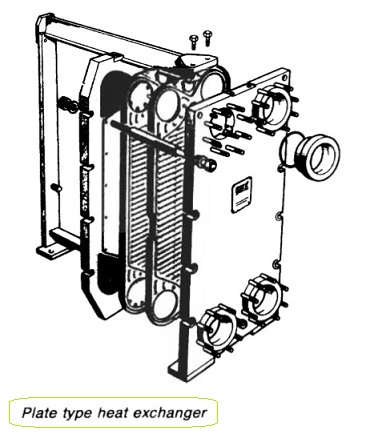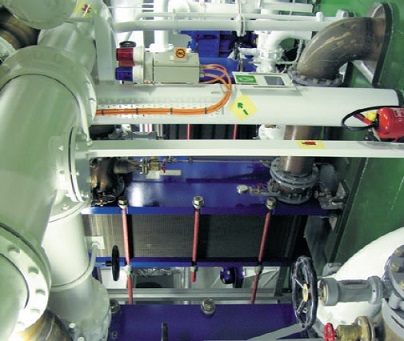
Figure 1: Plate type heat exchanger
The plates, which are supported beneath and located at the top by parallel metal bars, are held together against an end plate by clamping bolts. Four branch pipes on the end plates, align with ports in the plates through which two fluids pass. Seals around the ports are so arranged that one fluid flows in alternate passages between plates and the second fluid in the intervening passages, usually in opposite directions.
The plate corrugations promote turbulence (Figure 2 ) in the flow of both fluids and so encourage efficient heat transfer. Turbulence as opposed to smooth flow causes more of the liquid passing between the plates to come into contact with them. It also breaks up the boundary layer of liquid which tends to adhere to the metal and act as a heat barrier when flow is slow.
The corrugations make the plates stiff so permitting the use of thin material. They additionally increase plate area. Both of these factors also contribute to heat exchange efficiency. Excess turbulence, which can result in erosion of the plate material, is avoided by using moderate flow rates. However, the surfaces of plates which are exposed to sea water are liable to corrosion/erosion and suitable materials must be selected.
Titanium plates although expensive, have the best resistance to corrosion/erosion. Stainless steel has also been used and other materials such as aluminium-brass. The latter may not be ideal for vessels which operate in and out of ports with polluted waters. The nitrile rubber seals are bonded to the plates with a suitable adhesive.
Removal is facilitated with the use of liquid nitrogen which freezes, makes brittle and causes contraction of the rubber seal which is then easily broken away. Other methods of seal removal result in plate damage. Nitrile rubber is suitable for temperatures of up to about 110 deg C. At higher temperatures the rubber hardens and loses its elasticity. The joints are squeezed when the plates are assembled and clamping bolts are tightened after cleaning.

Figure 2: Turbulence produced by plate corrugations

Fig: plate type heat exchanger for ship machinery
Use of Titanium
The corrosion resistance of titanium has made it a valuable material for use in sea-water systems whether for static or fast flow conditions. The metal is light weight (density 4.5 kg/m3) and has good strength. It has a tolerance to fast liquid flow which is better than that of cupro-nickel. It is also resistant to sulphide pollution in sea water.
While titanium has great corrosion resistance because it is more noble than other metals used in marine systems, it does tend to set up galvanic cells with them. The less noble metals will suffer wastage unless the possibility is reduced by careful choice of compatible materials, coating of the titanium, insulation or the use of cathodic protection.
Summarized below various circulating systems for motorships, some of the basic procedure of heat exchangers & control of temperatures:
- Sea water circulation-systems
- Shell and tube heat exchangers for engine cooling water and lubricating oil cooling
- Plate type heat exchanger
- Details of charged air cooler
- Maintenance of heat exchangers
- Central cooling system & Scoop arrangement for motorships
- Circulating systems for steamships
- Closed feed system and feed heating for motor ships
- Marine condenser assembly
- Three stage air ejector with internal diffusers
- Pressure governor for motor ships
- Liquid ring pump- Nash rotary liquid ring pumps
- The Weir electro-feeder - a multi-stage centrifugal pump
- Feed water heaters for motor ships
- Devaporizer & turbo-feed pump
- Typical de-aerator & Cascade trays
The usual arrangement for motorships has been to have sea-water circulation of coolers for lubricating oil, piston cooling, jacket water, charge air, turbo-charger oil (if there are sleeve type bearings) and fuel valve cooling, plus direct sea-water cooling for air compressors and evaporators....
Shell and tube heat exchangers for engine cooling water and lubricating oil cooling have traditionally been circulated with sea water. The sea water is in contact with the inside of the tubes, tube plates and water boxes....
The obvious feature of plate type heat exchangers, is that they are easily opened for cleaning. The major advantage over tube type coolers, is that their higher efficiency is reflected in a smaller size for the same cooling capacity....
The charge air coolers fitted to reduce the temperature of air after the turbo-charger and before entry to the diesel engine cylinder, are provided with fins on the heat transfer surfaces to compensate for the relatively poor heat transfer properties of air....
The only attention that marine heat exchangers should require is to ensure that the heat transfer surfaces should remain substantially clean and flow passage generally clear of obstructions. Indcation that fouling has occured is given by a progressive increase in the temperature difference between the two fluids, and change of pressure....
The corrosion and other problems associated with salt water circulation systems can be minimized by using it for cooling central coolers through which fresh water from a closed general cooling circuit is passed. The salt water passes through only one set of pumps, valves and filters and a short length of piping.....
The main sea-water circulating system for a ship with main propulsion by steam turbine is similar to that of a motorship with a central cooling system. The difference is that the sea water passes through a ....
To ensure trouble-free operation of water-tube boilers the feed water must be of high quality with a minimal solid content and an absence of dissolved gases. Solids are deposited on the inside surfaces of steam generating tubes,....
A condenser is a vessel in which a vapour is deprived of its latent heat of vaporization and so is changed to its liquid state, usually by cooling at constant pressure. In surface condensers, steam enters at an upper level, passes over tubes in which cold sea water circulates, falls as water to the bottom and is removed by a pump (or flows to a feed tank)....
A steam-jet ejector may be used to withdraw air and dissolved gases from the condenser. In each stage of the steam-jet ejector, high pressure steam is expanded in a convergent/divergent nozzle. ...
The main feature of the governor is that if the pump loses suction the steam ports are opened wide, allowing the pump to accelerate rapidly to the speed at which the emergency trip acts....
Nash rotary liquid ring pumps, in association with atmospheric air ejectors, may be used instead of diffuser-type steam ejectors and are arranged as shown...
A multi-stage centrifugal pump mounted on a common baseplate with its electric motor. The number of stages may vary from two to fourteen depending upon the capacity of the pump and the required discharge pressure....
Surface or direct contact feed heaters, play an important part in the recovery of latent heat from exhaust steam. Direct contact feed heaters are also known as de-aerators....
If the de-aerator cannot be vented to atmosphere or to a gland condenser satisfactorily, a devaporizer is connected to the vapour outlet condensing the vapour vented with the non-condensable gases and cooling these gases before they are discharged. ...
Normally, the de-aerator is mounted directly on a storage tank, into which the de-aerated water falls, to be withdrawn through a bottom connection by a pump or by gravity. The tank usually has a capacity....
Home page||Cooling ||Machinery||Services ||Valves ||Pumps ||Auxiliary Power ||Propeller shaft ||Steering gears ||Ship stabilizers||Refrigeration||Air conditioning ||Deck machinery||Fire protection||Ship design ||Home ||
General Cargo Ship.com provide information on cargo ships various machinery systems -handling procedures, on board safety measures and some basic knowledge of cargo ships that might be useful for people working on board and those who ashore. For any remarks please Contact us
Copyright © 2010-2016 General Cargo Ship.com All rights reserved.
Terms and conditions of use
Read our privacy policy|| Home page||